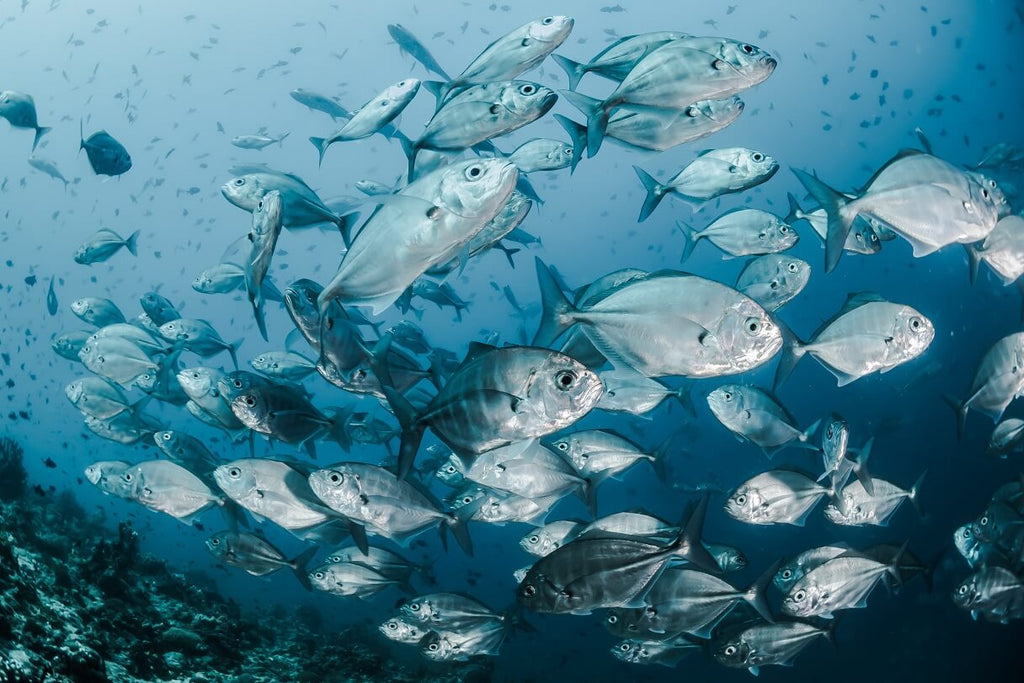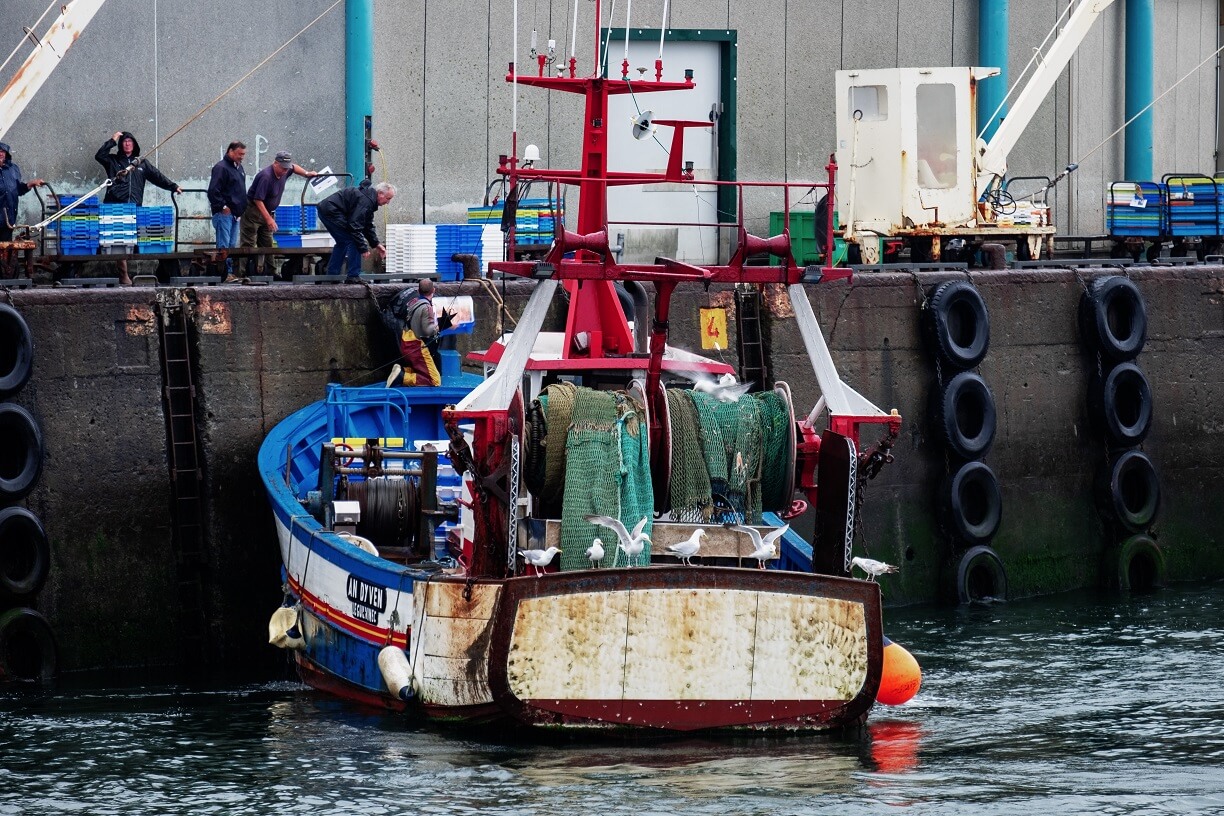What are Sustainable Ingredients?
What happens to make that almond milk pourable into your glass? How does vegan cheese actually become melty...

Curious about the overfishing status of the world’s oceans? Take an in-depth look at overfishing the past and present, plus overfishing solutions.
You don’t have to be a seafood lover for the thought of a dwindling ocean bounty to make your heart drop. The world’s oceans and sea creatures face a mounting threat from all sides. As carbon emissions lead to global warming and ocean acidification, the natural environment for our fish friends become less habitable. That means less fish.
Yet, the world’s appetite for seafood is still strong. That appetite feeds the fishing industry, with jobs, and humanity with food. But, where does that leave the health of the fish population, already threatened by environmental changes? Today, we’ll take a comprehensive look at overfishing, then discuss some possible overfishing solutions.
Overfishing refers to the depletion of fish from our oceans. If we catch so many fish that there are not enough to breed and replace themselves, that is considered overfishing. If a species is continually overfished it runs the risk of not only becoming extinct, but also imbalancing the oceanic ecosystem and putting other species at risk as well.
In the U.S., the National Oceanic and Atmospheric Administration (NOAA) track fish populations throughout U.S. waters and use various calculations to make their forecasts and place fish stocks into different risk categories.
To assign a risk category, fish stocks in different areas need to be assessed using catch data, abundance, and other biological data points. This data can then be plugged into a mathematical model to assess risk, and make regulatory adjustments to help protect those fish stocks if necessary.
First of all, the NOAA uses a metric called maximum sustainable yield (MSY). This is a calculation that predicts the largest long-term average catch that can be taken from a stock under the current environmental conditions. The MSY represents the maximum amount of fish that can be caught sustainably over a long term period. Based on a fish stock’s MSY, it can be categorized into three different groups.
If the harvest rate of a fish stock exceeds the MSY the NOAA adds it to an overfishing list. If the population of a fish stock is too low to maintain the MSY, it’s considered overfished. To help restore and protect fish in these classifications, the NOAA works with fisheries and invokes policies to help protect those species with a rebuilding plan. When those fish return to a sustainable level where they can meet their MSY, they’re considered rebuilt.

One of the earliest recordings of overfishing was whaling during the 1800s when whales were extensively hunted as a source of meat and oil
Whaling dates back to 3000 BC, but with increased whaling, and technological advancements many populations were decimated almost to the point of extinction during the 1800s. Blubber was harvested from whales to produce lamp oil, candles and other everyday items, like soap.
It’s estimated that 50,000 whales were killed per year by the 1930s, and in 1986 the International Whaling Commision banned commercial whaling due to massive overfishing. Whaling remains an issue of discussion, especially as Japan recently resumed commercial whaling after 30 years.
Due to climate and overfishing, there was also a massive decline of sardines on the west coast in the mid-1900s, but the populations were replenished by the 1990s.
In the 1980s, Blue walleye were made extinct in the Great Lakes due to overfishing and environmental changes. Prior to their extinction, an estimated half million tons of Blue walleye were harvested from the Great Lakes from the 1880 to the 1950s.
In 1996, to help curtail overfishing practices, the U.S. congress passed The Sustainable Fisheries Act, which also defined overfishing.
According to a recent report from NOAA, there is some good news. In 2018, the number of overfished fish stocks is at a near all-time low. Since 2000, there have been 45 fish stocks rebuilt back to a sustainable level in the U.S. and a majority of U.S. fish stocks that are overfished are at an all-time low.
The recent news is encouraging, and suggests that U.S. fishery management is on track to achieve its long-term conservation goals. However, this does not reflect the fish populations elsewhere in the world, since NOAA does not track populations beyond U.S. waters. Also, although improvements are being made, it’s important to recognize the current status of our fish populations, and which ones are the most at risk.
The NOAA tracks a total of 479 fish stocks throughout the U.S. However, the status of some of those fish stocks are unknown. Of 321 stocks with a known overfishing status, 9% of them were on the overfishing list in 2018. Of 244 stocks with a known overfished status, 18% were considered overfished.
When you narrow your focus to look at some of the primary fish populations that were considered overfished or added to the overfishing list, here’s what you’ll notice:
6 salmon populations were added
2 snapper populations were added
2 mackerel populations were added
1 Tuna population was added
What stands out?
First of all, all of these fish are commonly consumed in human diets. Typically, Salmon and Tuna ranks as the first and second highest consumed fish. In particular, salmon, which is considered a healthy source of omega-3 fatty acids shows up on the lists to an alarming extent. NOAA also ranks salmon as the highest value U.S. species, with $688 million harvested in 2017.
Overall, the United Nations Food and Agriculture Organization estimates that 33.1% of global fish stocks are threatened by overfishing. In 1974 it’s been estimated that 90% of fish stocks were at biologically sustainable levels. In 2015, that estimate had declined to 67%. Correspondingly, the percentage of fish harvested at an unsustainable level increased from 10% in 1974 to 33% in 2015.
Overfishing is happening throughout the world. NOAA’s 2018 report provides detailed information on which fish species are being overfished, by location. In the Pacific regions of the United States, including Alaska, Washington, Oregon, Idaho, California and Hawaii there are 13 fish stocks threatened by overfishing. On the Atlantic coast, from New England to Florida there are 25 Fish stocks at risk.
Globally, overfishing has threatened many fisheries. In 2015, the Mediterranean and Black Sea had the most unsustainable fish populations, followed by the Southeast Pacific, and Southwest Atlantic regions.
As regional fish stocks dwindle, they can also have a profound effect on the economy of those regions as well. In the North Sea, and the Grand Banks of Newfoundland, overfishing throughout the 20th century led to fishery closures and extensive job losses threatening the communities associated with the industry.
Perhaps the most extreme example of the economic effects of overfishing is the collapse of Newfoundland cod fisheries in the North Atlantic region of Canada. In 1993, the population of cod dropped to 1% of previous levels. The region, shaped by 500 years of cod fishing was decimated. Almost 40,000 people lost their jobs when the fish suddenly stopped showing up.
Given that millions of people rely on fishing for their food and livelihood, it’s in our best interest to protect our existing fish stocks to help support future generations. Technological advances that have occurred in the past 200 years have drastically altered the way that modern fishing vessels operate allowing them to make massive increases in their fishing productivity. With large nets and vessels they are able to catch more fish than ever before, increasing their profits.
But, as the global population continues to grow, the need for sustainability increases. We must harvest fish in a way to provide food, but we need to strategically manage our fishing practices so that those fish can continue to provide food for generations to come.
Solving the problem requires a comprehensive approach that expands from policy to personal choices. These overfishing solutions include:
From a macro level, it’s important to recognize that a problem exists, and then to collect data over time to track progress. We can also use that data to make strategic policy decisions to help protect areas that are at a high risk for overfishing.
In the U.S., NOAA tracks data on fish populations and then helps to inform different regulations. By closing breeding areas or creating protected marine areas, regulations can protect fish stocks allowing them to replenish.
Regulations can also be set to limit the length of fishing seasons, or restrict certain fishing methods like bottom trawling. Bottom trawling involves dragging a large net with weights across the ocean floor, and is a highly unselective method of fishing. It’s estimated that 90% of trawl catch is collateral damage, meaning it was unintended catch. The mistakenly caught fish must be thrown overboard, but are often killed in the process.
By regulating these practices, governments can help to support sustainable fish populations into the future, and help to rebuild at-risk fish stocks. However, this requires the shared participation by governments worldwide to help curtail overfishing through policy.
From an individual standpoint, you can also help to support sustainable fishing practices, by engaging in sustainable consumption.
While health experts often recommend increasing seafood intake, it’s hard not to recognize the potential impact increased fish consumption may have on fishing populations. In 2016, 88% of fish caught were for human consumption, a 21% increase since the 1960s.
While it’s good that a majority of fish catch is being directed to human consumption, we also need to be conscientious of the impact our consumption has.
Choose Sustainable Seafood. One thing you can do if you eat seafood is to only purchase seafood from sustainable sources. That means choosing farmed sources, or fisheries that can maintain production without harming their ecosystems. To find products from such sources you can look for The Marine Stewardship Council’s blue ecolabel, which is granted based on an established standard for sustainable fishing practices.
You can also choose fish species that breed young and grow quickly such as sardines and anchovies, both of which are high in omega-3 fatty acids, like salmon. For more guidance on sustainable fish choices, you can check out the Monterey Bay Aquarium’s Seafood Watch.
Choose Alternative Food Sources. Health professionals often recommend eating fish twice per week, due to multiple health benefits associated with seafood consumption. In particular, salmon is often considered an incredible nutrient dense food because it provides a quality source of protein and is high in heart healthy omega-3 fatty acids.
However, there are a variety of other foods high in omega-3 fatty acids that also serve as high-quality protein sources. And, by substituting these sources for fish, you can reduce your impact on fish stocks.
In particular, crickets, a highly sustainable source of protein also provide a healthy dose of omega-3. In the cricket powder used in a protein bar by EXO, 100 g of flour contains about 340 mg of Omega-3. It’s generally recommended by health organizations to consume between 250-500 mg of Omega-3 per day.
You don’t need to replace all your meals with crickets. But by supplementing some of your protein and omega-3s from crickets, you can support your own nutrition, and the health of future fish stocks. For the more adventurous, you can add some whole roasted crickets along with your favorite nuts to a fresh salad. Or, if you prefer something less adventurous, but incredibly tasty, toss a PB&J protein bar with cricket flour into your workout bag.
Other foods high in omega-3 fatty acids also include chia seeds, flaxseeds, walnuts and soybeans.
Hopefully this post left you with some ideas as to how you can help reduce your impact on our global fish supply so we can keep our oceans healthy and thriving!